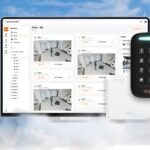Purchasing System Results in Long-term Savings
During the procurement process, University of Maryland officials determined it would make the most sense to purchase their new RSAN outright. They determined that the purchase price of $70,000 and yearly maintenance cost of $7,000 would be less expensive than paying a yearly fee for the institution’s 50,000 students, faculty and staff. Today, Gruber still believes his institution’s decision to buy the system was correct.

“If we stop paying the maintenance costs and offsite hosting fees, we own the system,” says Gruber. “We can still use it, and we don’t have to pay any other costs. However, we choose to pay the upgrade and maintenance costs because they are minimal and keep us state of the art. We have access to their technicians to ask questions and tweak things.”
That access to Cooper technicians helped recently when the campus transitioned from an opt-in sign-up process to an opt-out approach. “Our IT department worked with Cooper in a secure way to transfer all of those E-mail addresses,” says Gruber. “Cooper did all of the back-end work to make sure there weren’t duplicates and to get people on the system.”
Opt-Out Approach Encourages Participation
Gruber determined the campus needed to adopt the opt-out method for signing up users because the opt-in approach wasn’t getting enough participation. “We did a lot of marketing and pushes to get people to sign up, and we were still just shy of 50 percent,” he says.
Now, everyone who has a campus- issued E-mail is automatically enrolled in the E-mail emergency alert system. “We send a welcome message to all of the new users, letting them know that if they don’t want to get these messages, they can reply to the E-mail with the word ‘stop,’” says the major. “If they want to add text messaging, they need to click a link that directs them to the system where they create a password and put in their cell information.”
To make the opt-in process even more effective, the school will add a field to the class registration page so that students can provide their cell numbers at the beginning of the school semester. Gruber estimates this update will take about a year to accomplish, however, because the process of change is slow.
In the meantime, RSAN has a rapid enrollment feature that is an easy way for new students to sign up for the service. “We capture a large number of people when we do safety and security presentations, sexual assault presentations, alcohol and drug awareness presentations, and parent and new student orientations,” says Gruber. “A police officer who is presenting asks, ‘How many of you are registered for the text alert system?’ Not many people raise their hands. He or she then asks ‘How many of you have a cell phone on you right now?’ and everyone raises their hands. The officer says ‘Take them out and let’s do this together.’ We get people in bulk that way.”
Cooper Notification also helps with the system’s database management. After three unsuccessful attempts to reach a person via E-mail or text, the person is automatically dropped.
Testing the System Verifies Throughput Speed
Testing the system regularly also helps with database management. On the first Wednesday of each month, all of the school’s mass notification systems, including its sirens, texting, E-mail and Alertus boxes are tested. After three months of bounce-backs from an E-mail or text test, a user is removed from the system.
Additionally, testing helps campus officials determine how quickly messages are being received. According to Gruber, 96 percent of the text messages sent to the school’s more than 25,000 subscribers arrive within three to four minutes. The E-mail emergency alerts also are received quickly by the campus’ 65,000 E-mail addresses. “An E-mail automatically generated here by our mega mail system can take up to 45 minutes to get to everyone,” says Gruber. “The E-mails generated by Cooper get out instantaneously.”
When it comes to testing the system from the back-end, the University of Maryland is an overachiever. About 50 drills are conducted a year. Basically, everything is done but pushing the button to send a test to the students. The drills, however, do involve first responders and facilities personnel so they’ll remain current on the system.












